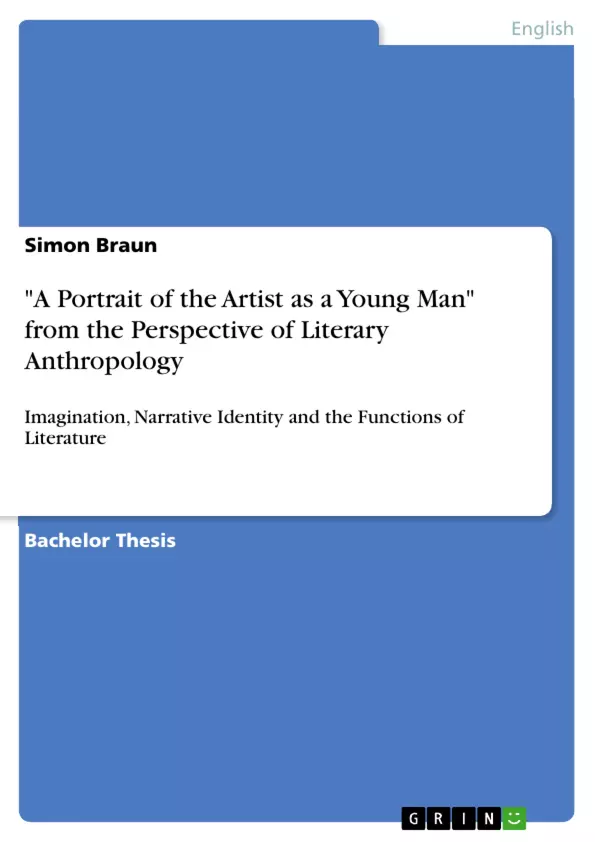Stories can offer support in finding a position and orientation in the world, and thereby provide a foundation for one’s identity. In this thesis, the uses of literature and fiction shall be examined with special regard to the questions of what further insights this may reveal about us as humans and about the psychological functions of narrative for the construction of an identity. It will be asked how and to what end our psyche and mind become unfolded in fiction and consequently, what this in turn reveals about the condition of being human.
Drawing on different theoretical strands from the field of Literary Anthropology, the first chapter will be dealing with the work of Arnold Gehlen as a basis for later, in-depth textual analysis. His ideas are helpful for the explanation of how humans have evolved from mere instinct-driven animals to complex, self-reflexive creatures that have created a culture that uses symbols and the power of imagination in order to make sense of themselves and as a basis for action and productive orientation towards the future. This also paves the way for an examination of Wolfgang Iser’s work, which will be consulted in order to find out how literature may come to resemble the primary medium reflecting and embodying human development as well as the unfolding and development of the self.
Fiction and its aesthetic possibilities will be presented as a prominent way of exploring, understanding and expressing human needs. In the main part of this thesis, these findings will be applied to and discussed on the basis of James Joyce’s 1916 novel A Portrait of the Artist as a Young Man. This is especially illuminating, because the novel deals with the topics of imagination, the functions of literature and the (self-) determination of identity on a content-level. Moreover, its self-reflexivity on a formal and aesthetic level refers back to the theoretical works of Gehlen and Iser, since by doing so the potential and/or limitations of Literary Anthropology may be embodied, highlighting some contradictions inherent to fiction.
To conclude these discussions, a brief digression on the significance of narrative to personal identity as well as on the act of staging an identity will follow at the end of this paper.
Inhaltsverzeichnis (Table of Contents)
- Introduction: Humans and Fiction
- Arnold Gehlen's Philosophical Anthropology
- Wolfgang Iser: Literature as a Medium and Mirror of Human Self-Unfolding
- James Joyce's A Portrait of the Artist as a Young Man
- History and Politics
- Religion
- Family and Friends
- Literature and Art
- The Artist's Identity
- Language
- Forms of Play
- Educational Path: Life versus Art
- Inherent Contradictions of Fiction
- Self-Staging: Identity and Narration
- Conclusion: Fiction and Identity
Zielsetzung und Themenschwerpunkte (Objectives and Key Themes)
This thesis examines the uses of literature and fiction, particularly focusing on how they contribute to understanding human identity formation. It investigates the psychological functions of narrative and explores how our minds and psyches are unfolded through fiction. Ultimately, it aims to uncover what these processes reveal about the human condition.
- The role of imagination and symbolism in making sense of the world and the self.
- The relationship between literature and human development, with a focus on the unfolding of the self.
- The inherent contradictions and possibilities of fiction as a means of exploring and expressing human needs.
- The significance of narrative in constructing personal identity and the act of "staging" an identity.
- The connection between literary anthropology and the analysis of specific literary works.
Zusammenfassung der Kapitel (Chapter Summaries)
The first chapter introduces the concept of "humans and fiction," exploring the universal human tendency to tell stories and create narratives. It argues that storytelling serves as an attempt to find meaning and orientation in the world and plays a crucial role in identity formation. The second chapter examines Arnold Gehlen's philosophical anthropology, emphasizing the concept of "Mängelwesen" (deficient being) and its implications for understanding human culture and civilization. Gehlen's theory suggests that humans, lacking instinctive adaptations, rely on imagination, symbols, and culture to make sense of their existence and orient themselves towards the future. The third chapter analyzes Wolfgang Iser's ideas on literature as a medium and mirror of human self-unfolding, highlighting the aesthetic possibilities of fiction in exploring human needs and desires. This chapter lays the groundwork for the subsequent analysis of James Joyce's "A Portrait of the Artist as a Young Man" in the following chapter.
Schlüsselwörter (Keywords)
This thesis focuses on the intersection of literary anthropology, narrative theory, and literary analysis. Key terms and concepts include "Mängelwesen," imagination, symbolism, self-reflection, identity construction, narrative function, and the aesthetics of fiction. The analysis draws heavily on the works of Arnold Gehlen and Wolfgang Iser, while examining James Joyce's "A Portrait of the Artist as a Young Man" as a case study. This work delves into the themes of self-determination, artistic development, and the impact of cultural and societal influences on individual identity.
- Arbeit zitieren
- Simon Braun (Autor:in), 2019, "A Portrait of the Artist as a Young Man" from the Perspective of Literary Anthropology, München, GRIN Verlag, https://www.grin.com/document/1186877



